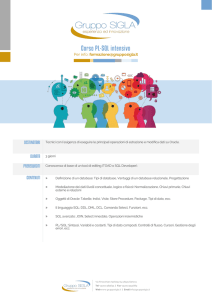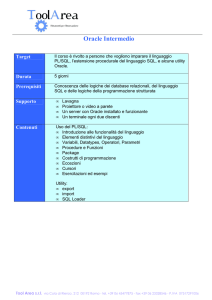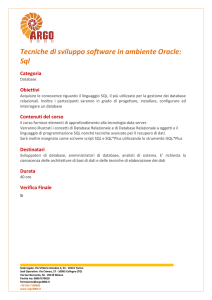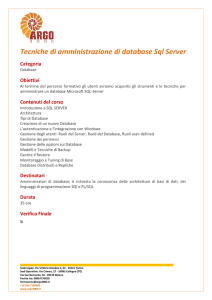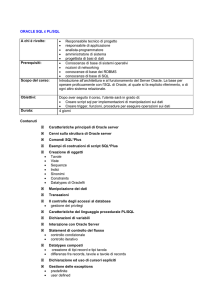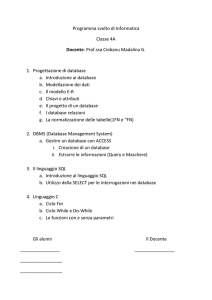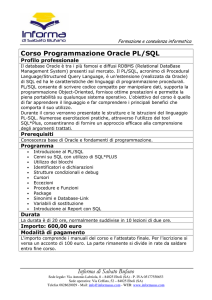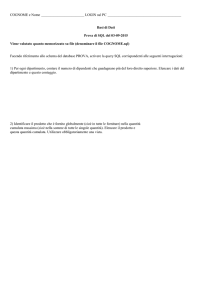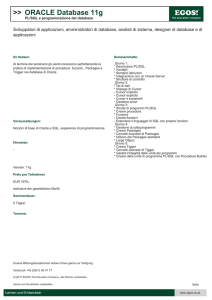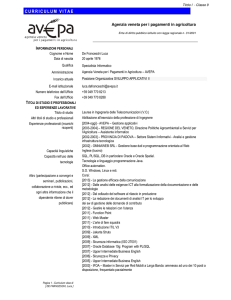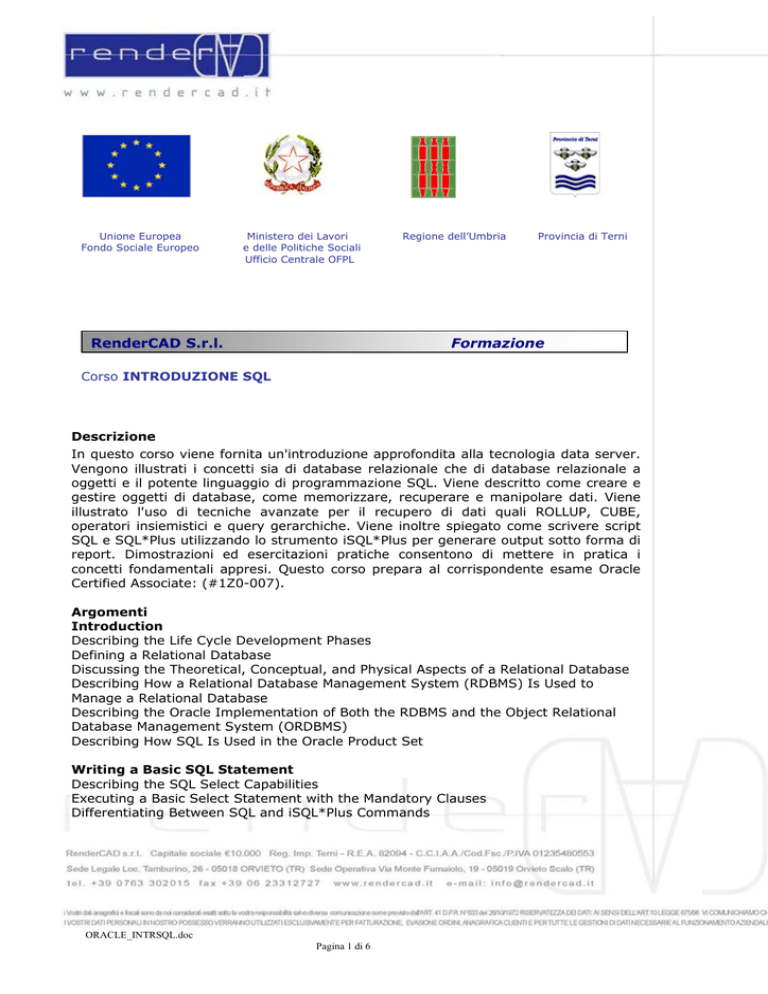
Unione Europea
Fondo Sociale Europeo
Ministero dei Lavori
e delle Politiche Sociali
Ufficio Centrale OFPL
RenderCAD S.r.l.
Regione dell’Umbria
Provincia di Terni
Formazione
Corso INTRODUZIONE SQL
Descrizione
In questo corso viene fornita un'introduzione approfondita alla tecnologia data server.
Vengono illustrati i concetti sia di database relazionale che di database relazionale a
oggetti e il potente linguaggio di programmazione SQL. Viene descritto come creare e
gestire oggetti di database, come memorizzare, recuperare e manipolare dati. Viene
illustrato l'uso di tecniche avanzate per il recupero di dati quali ROLLUP, CUBE,
operatori insiemistici e query gerarchiche. Viene inoltre spiegato come scrivere script
SQL e SQL*Plus utilizzando lo strumento iSQL*Plus per generare output sotto forma di
report. Dimostrazioni ed esercitazioni pratiche consentono di mettere in pratica i
concetti fondamentali appresi. Questo corso prepara al corrispondente esame Oracle
Certified Associate: (#1Z0-007).
Argomenti
Introduction
Describing the Life Cycle Development Phases
Defining a Relational Database
Discussing the Theoretical, Conceptual, and Physical Aspects of a Relational Database
Describing How a Relational Database Management System (RDBMS) Is Used to
Manage a Relational Database
Describing the Oracle Implementation of Both the RDBMS and the Object Relational
Database Management System (ORDBMS)
Describing How SQL Is Used in the Oracle Product Set
Writing a Basic SQL Statement
Describing the SQL Select Capabilities
Executing a Basic Select Statement with the Mandatory Clauses
Differentiating Between SQL and iSQL*Plus Commands
ORACLE_INTRSQL.doc
Pagina 1 di 6
Unione Europea
Fondo Sociale Europeo
Ministero dei Lavori
e delle Politiche Sociali
Ufficio Centrale OFPL
RenderCAD S.r.l.
Regione dell’Umbria
Provincia di Terni
Formazione
Corso INTRODUZIONE SQL
Restricting and Sorting Data
Limiting the Rows Retrieved by a Query
Sorting the Rows Retrieved by a Query Single Row Functions
Describing Various Types of Functions Available in SQL
Using a Variety of Character, Number, and Date Functions in SELECT Statements
Explaining What the Conversion Functions Are and How They Are Used
Using Control Statements
Displaying Data from Multiple Tables
Writing SELECT Statements to Access Data from More Than One Table
Describing the Cartesian Product
Describing and Using the Different Types of Joins
Writing Joins Using the Tips Provided
Aggregating Data by Using Group Functions
Identifying the Different Group Functions Available
Explaining the Use of Group Functions
Grouping Data by Using the GROUP BY Clause
Writing Subqueries
Describing the Types of Problems That Subqueries Can Solve
Describing Subqueries
Listing the Types of Subqueries
Writing Single-Row and Multi-Row Subqueries
Describing and Explaining the Behavior of Subqueries When NULL Values Are Retrieved
Producing Readable Output with iSQL*Plus
Producing Queries That Require an Input Variable
Customizing the iSQL*Plus Environment
Producing More Readable Output
Creating and Executing Script Files
ORACLE_INTRSQL.doc
Pagina 2 di 6
Unione Europea
Fondo Sociale Europeo
Ministero dei Lavori
e delle Politiche Sociali
Ufficio Centrale OFPL
Regione dell’Umbria
RenderCAD S.r.l.
Provincia di Terni
Formazione
Corso INTRODUZIONE SQL
Manipulating Data
Describing Each Data Manipulation Language (DML) Command
Inserting Rows into a Table
Updating Rows in a Table
Deleting Rows from a Table
Merging Rows into a Table
Controlling Transactions
Describing Transaction Processing
Describing Read Consistency and Implicit and Explicit Locking
Creating and Managing Tables
Describing the Main Database Objects
Creating Tables
Describing the Oracle Data Types
Altering Table Definitions
Dropping, Renaming, and Truncating Tables
Including Constraints
Describing Constraints
Creating and Maintaining Constraints
Creating Views
Describing Views and Their Uses
Creating a View
Retrieving Data by Means of a View
Inserting, Updating, and Deleting Data Through Views
Dropping Views
Altering the Definition of a View
Inline Views
Top 'N' Analysis
ORACLE_INTRSQL.doc
Pagina 3 di 6
Unione Europea
Fondo Sociale Europeo
Ministero dei Lavori
e delle Politiche Sociali
Ufficio Centrale OFPL
RenderCAD S.r.l.
Regione dell’Umbria
Provincia di Terni
Formazione
Corso INTRODUZIONE SQL
Other Database Objects
Creating, Maintaining, and Using Sequences
Creating and Maintaining Indexes
Creating Private and Public Synonyms
Controlling User Access
Understanding the Concepts of Users, Roles, and Privileges
Granting and Revoking Object Privileges
Creating Roles and Granting Privileges to Roles
Creating Synonyms for Ease of Table Access
SQL Workshop
Applying Techniques Learned in This Course
Preparing for Future Oracle Courses
Using Set Operators
Describing the Set Operators
Obeying the Set Operators Rules and Guidelines
Using a Set Operator to Combine Multiple Queries into a Single Subquery
Controlling the Order of Rows Returned
Oracle 9i Datetime Functions
Using DATETIME Functions
Using the NVL2 Function to Handle NULL Values
Enhancements to the GROUP BY Clause
Using ROLLUP as an Extension to the GROUP BY Clause to Produce Subtotal Values
Using CUBE as an Extension to the GROUP BY Clause to Produce Cross-Tabulation
Values
ORACLE_INTRSQL.doc
Pagina 4 di 6
Unione Europea
Fondo Sociale Europeo
Ministero dei Lavori
e delle Politiche Sociali
Ufficio Centrale OFPL
RenderCAD S.r.l.
Regione dell’Umbria
Provincia di Terni
Formazione
Corso INTRODUZIONE SQL
Using the GROUPING Function to Identify the Row Values Created by ROLLUP or CUBE
Operators
Using GROUPING SETS to Produce a Single Result Set That Is Equivalent to a UNION
ALL Approach
Using the WITH Clause
Advanced Subqueries
Multiple-Column Subqueries Writing a Subquery in the FROM Clause
Writing and describing Correlated Subquery
Using EXISTS and NOT EXISTS Operators
Updating and Deleting Rows Using Correlated Subqueries
Using Scalar Subqueries in SQL
Hierarchical Retrieval
Discussing the Benefits of the Hierarchical Query
Ordering the Rows Retrieved by a Query in a Hierarchical Manner
Formatting Hierarchical Data so That It Is Easy to Read
Excluding Branches from the Tree Structure
Oracle9i Extensions to DML and DDL Statements
Discussing Multitable Inserts Creating and Using External Tables
Naming the Index and Using the CREATE INDEX Command at the Time of Creating
Primary Key Constraint
Obiettivi
controllare l'accesso degli utenti ai dati;
controllare le transazioni;
creare e gestire oggetti di database;
descrivere i concetti di database relazionale e database relazionale a oggetti
ORACLE_INTRSQL.doc
Pagina 5 di 6
Unione Europea
Fondo Sociale Europeo
Ministero dei Lavori
e delle Politiche Sociali
Ufficio Centrale OFPL
RenderCAD S.r.l.
Regione dell’Umbria
Provincia di Terni
Formazione
Corso INTRODUZIONE SQL
eseguire comandi INSERT su più tabelle e utilizzare tabelle esterne;
recuperare, inserire, aggiornare ed eliminare dati;
risolvere problemi utilizzando subquery che restituiscono più colonne, subquery nella
clausola FROM di un'istruzione SELECT, subquery correlate e subquery scalari;
scrivere script SQL che utilizzano il linguaggio SQL per generare istruzioni SQL;
utilizzare GROUPING SETS e la clausola WITH;
utilizzare comandi iSQL*Plus di base;
utilizzare iSQL*Plus per formattare report.
utilizzare le nuove funzioni che agiscono su una sola riga DATETIME e NVL2 disponibili
in Oracle;
utilizzare tecniche avanzate per il recupero di dati quali ROLLUP, CUBE, operatori
insiemistici, subquery correlate e query gerarchiche;
Partecipanti
Analisti di sistema
Amministratori di database
Personale Tecnico di supporto
Prerequisiti obbligatori
Conoscenza dei concetti e delle tecniche di elaborazione dei dati
Prerequisiti suggeriti
Capacità di utilizzare un'interfaccia GUI
Docenti
Personale docente Oracle University.
Durata del corso: 30 ore, in 5 giorni.
ORACLE_INTRSQL.doc
Pagina 6 di 6


